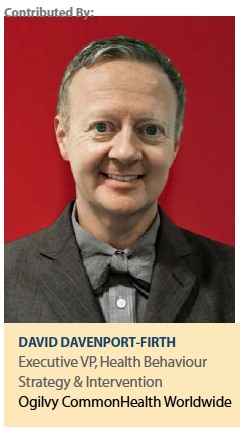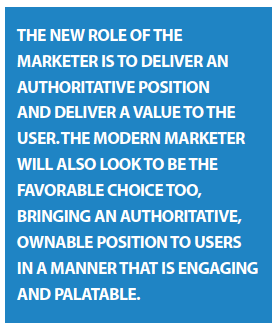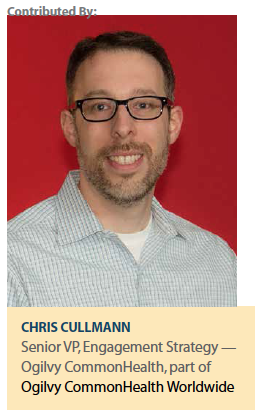 The model for marketing healthcare brands is changing. There are many voices for health, pharmaceutical, and “wellness" products. When we are creating materials for a brand, we should look at the users for who they are: people who are motived by their own needs, interests, desires, and constraints. They have infinite choices and a myriad of sources for information on pharmaceutical products and can chose from as many types of narratives, stories, and styles of storytelling.
The model for marketing healthcare brands is changing. There are many voices for health, pharmaceutical, and “wellness" products. When we are creating materials for a brand, we should look at the users for who they are: people who are motived by their own needs, interests, desires, and constraints. They have infinite choices and a myriad of sources for information on pharmaceutical products and can chose from as many types of narratives, stories, and styles of storytelling.
Do you know who maintains the authority position online or off for your brand or condition? Equally as important: who commands the largest share of voice? Pharmaceutical brands need to use their expertise and research to be THE canonical resource for their product when physicians, patients, and caregivers want to really understand a therapy. This is why creating for behavior change is so critical in a competitive market.
Marketers have to move quickly to surface on their users’ radar. Patients, caregivers, and even healthcare professionals have little opportunity to read every article to compare all sources to determine the most authoritative website or author. They are typically motivated through a discovery process that is difficult to navigate and often fraught with difficult literature and conflicting opinion. This motivation is typically one driver of many. Pharmaceutical and healthcare brands need to be consistent and persistent to reach audiences.
Message and Volume
The modern patient, caregiver, and physician all have access to a limitless well of information. The availability of information creates a massive challenge for both user and content creator. For many users, what they are drawn to is the content that they find “favorable." The information that is accessible, visual, easily discoverable, and even appearing first in search engines may not be the best information. This is the challenge, and opportunity, for the modern healthcare communicator.
 Aligning the messaging to audience is not a new principle for marketers. The modernization of this idea is becoming accelerated with better curating, improvements in online search, and how easy it is to publish a perspective. The volume of information also creates a tension for users and content creators — there is consumption fatigue for all users, and providing your brand’s content as high in the consumption cascade, regardless of channel, is critical.
Aligning the messaging to audience is not a new principle for marketers. The modernization of this idea is becoming accelerated with better curating, improvements in online search, and how easy it is to publish a perspective. The volume of information also creates a tension for users and content creators — there is consumption fatigue for all users, and providing your brand’s content as high in the consumption cascade, regardless of channel, is critical.
The new role of the marketer is to deliver an authoritative position and deliver a value to the user. The modern marketer will also look to be the favorable choice too, bringing an authoritative, ownable position to users in a manner that is engaging and palatable. The reason this is so critical is that behavior change, especially to healthcare brands, is so closely tied to audiences understanding messaging and engaging with it repeatedly.
For healthcare brands defining themselves as authorities, they must be truthful, fair, and provide content that results in safe decisions for patients and physicians. These brands will also have to make their messages easily identified by search engines, meaningful enough for physicians to share and discuss with peers, and for patients to read, understand, and consider relative to their own experiences and positions.
Favorable Content vs.Valuable Content
People are drawn to the content that is approachable and reaffirms their beliefs. This is both reassuring, but potentially detrimental to behavior change. Brands need to be producing content that is valuable and approachable for audiences. Healthcare brands—please hear this as a rally cry: re-declaring common knowledge or simply re-publishing content in an app or new medium is not valuable.
 Content producers must ask themselves: “What can I serve to users in their time of need? What might they be searching for? How can I be relevant to them right now? What will they need later? Can I continue to provide value after this particular point in time?" Be sure that the content can be understood, is memorable, and is discoverable, but also make sure that it is a genuine help to your specific target audience.
Content producers must ask themselves: “What can I serve to users in their time of need? What might they be searching for? How can I be relevant to them right now? What will they need later? Can I continue to provide value after this particular point in time?" Be sure that the content can be understood, is memorable, and is discoverable, but also make sure that it is a genuine help to your specific target audience.
The benefits content producers can give to patients are actually quite simple. They also play to where healthcare brands can be most authentic: in speaking about their own drugs. Researcher Howard Leventhal points to the cognitive needs of a patient: at their most basic, these needs are identifying symptoms and how an illness can manifest itself; the timeline of the illness and its symptoms; the cause of the illness; the consequences and how to control or manage them; and finally, whether overcoming the illness is possible.
For healthcare brands, being anything but the authority for a product is a missed opportunity.
Product information is both an authoritative position and one where brand stewardship is most evident. Bringing value to users searching for your brand is Opportunity One, and publishing materials for every audience in your ecosystem should be Priority One. From there, building a content strategy is an augmentation on a definitive position.
The shift for many brands towards success is to make their approach to “valuable" content favorable to their users. To reach a change in behavior (regimen, new product selection, or choice based on competitive advantage), the messaging will need to be identified by the audience, be perceived as valuable, keep the user engaged, and be considered authoritative. Are you really considering this when you create and audit your content?
Content Is Bigger Than Text
Content is no longer just text. Patients, caregivers, and healthcare professionals need information in many forms. Text content is still critical. It is widely known, used, works with healthcare’s regulatory processes, is easily indexed by computers, and is the most transportable medium. It fuels search, is easily shared, and can be amortized in brochures, direct mail, websites, mobile, social, and so on.
Even the simplicity of text is deceiving. Are you using storytelling and language that works for users who are just becoming aware of their illness and for users who are long-time sufferers? And what about patients with comorbidities? There are a lot of questions to ask yourself when reviewing new and existing architectures for your audience. Even healthcare professionals, trained as they are, are also on a journey to familiarize themselves and consider products for use with their patients.
Marketing professionals are aware of how imagery can enhance a brand story. Images, and visualized information in all forms, are an integral part of the brand story. How is your user engaging with your brand in their journey? Are you an oral therapy? How big is your pill? A simple question and not likely put into very many Google searches.
This kind of insight may be very important to some of your audience and it may put them at ease to know the oral therapy they are going to be prescribed is going to be physically easy to take.
Infographics and scientific visualizations are critical to communicating ideas quickly. When done correctly, these elements can also appear in search for easy access. This is where repeated exposure through search, sharing, and many branded touchpoints can cumulatively affect physician consideration, adoption, and effective communication with patients.
The strength of visuals is in the speed of communication, messaging recall, and ability to accelerate changes in attitude and intention. This has to point to the concept of authority and delivering value to audiences. This concept, and it is a very important one, is the pairing of written or “text" information with visuals to both provide discoverability for the user and to be impactful.
Video is a prime example: in the past year, online video consumption for 18- to 64-year-old Americans has gone from an average of 13 minutes a day to 27 minutes. There are few mediums that can telegraph emotion and intensity as video can. YouTube is the second most searched website on earth; providing content, especially for healthcare brands, delivers value and supersedes poor content currently occupying a whitespace. This being true, too many brands choose not to compete or to create a single video that tries to communicate a story in 7 minutes. Brands need to understand their audience and provide multiple videos that fit a niche of the user’s journey and then provide a regular cadence of updates. Frequency and rhythm over one or two longer engagements will help map brands to users’ needs.
There are many other mediums untapped by many in healthcare: audio with podcasts, radio programs, and recorded presentations on SlideShare (a social network for slide presentations). Audio provides a cost-effective episodic option, is inexpensive to produce, and can come to market quickly.
Measurement and Meaning
Many marketers envision, sell, and maintain programs that have serialized “journeys." Few actual journeys in life are linear. Many of us seek multiple input points, sources of information, mediums, and channels to identify and consume information. Some of those are conscious, some not. But they are all cumulative.
As healthcare communicators, we need to evolve our thinking and measurement to adapt to a rich, nonlinear world of marketing and become sophisticated in listening for what patients and HCPs are saying with their actions.
Measurement and the frameworks we use to gain insights from marketing should be sophisticated. They should underscore what we expect when we say behavior change, articulate and quantify that change. We need to build relationships with our consumers, not send them emails once a month, and proactively anticipate what they need for their journey. Even in medicine, people have choices. Markets are dynamic.
People look for new solutions when old ones don’t behave as expected. Behavior change is not a destination; it’s the beginning of a new dialogue. (PV)
Ogilvy CommonHealth Worldwide — the health behavior specialists of Ogilvy &
Mather — is committed to creativity and effectiveness in healthcare communications, everywhere.
For more information, visit ogilvychww.com
.


















